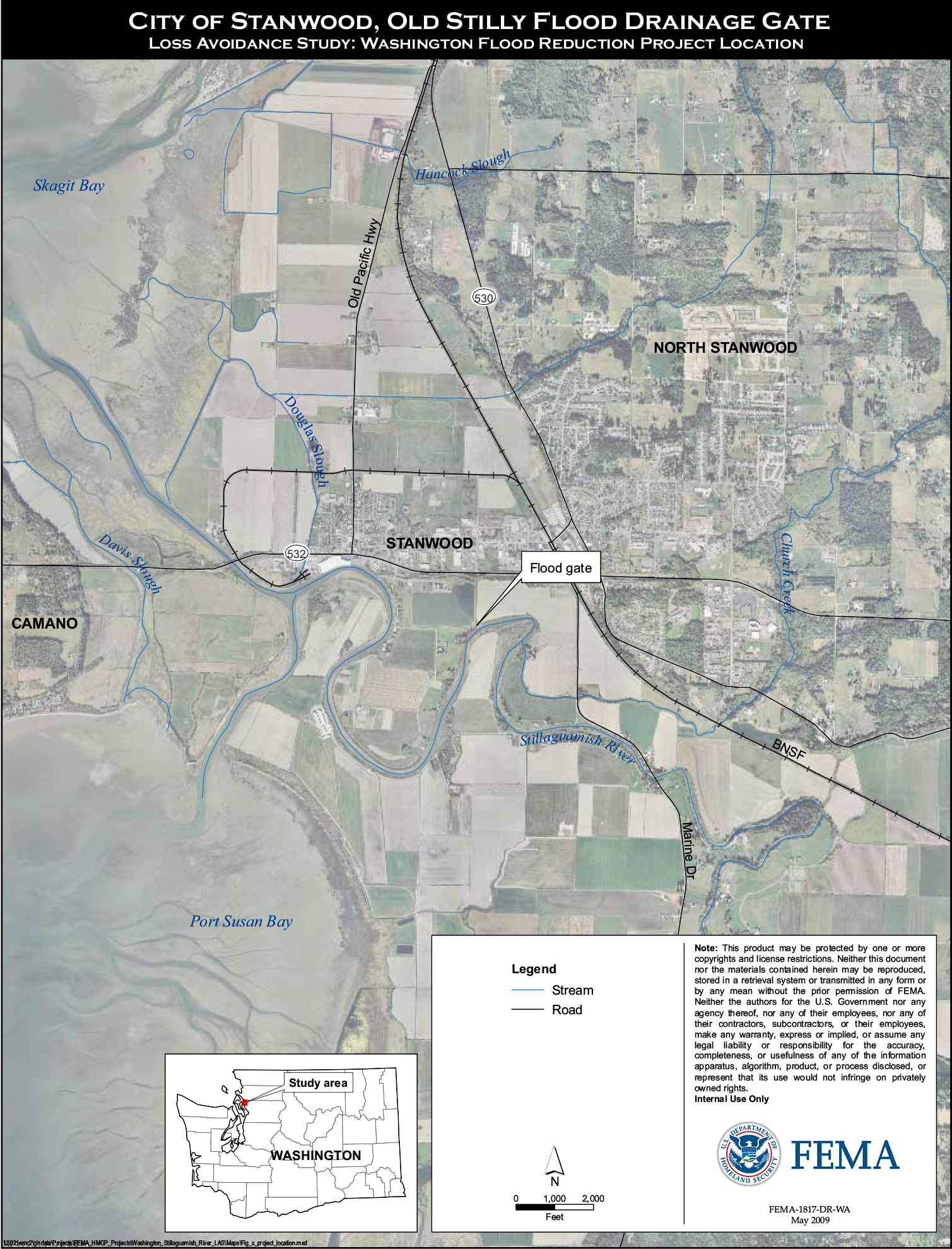Study Summary
Study Area – City of Issaquah and City of Stanwood, WA
Hazard Type – Riverine Flood
Project Type – Following the devastating 1996 floods in the State of Washington, local governments, with State and Federal assistance, completed a number of drainage improvement projects to reduce future damage from similar floods, including the following two:
- Tributary 0170 Drainage Improvement Project in the City of Issaquah – Tributary 0170 runs between the State Route 900 and Interstate 90 (SR 900/I-90) interchange and the Lake Sammamish State Park entrance road, where it then discharges to Tibbetts Creek. The project replaced two undersized corrugated metal pipe culverts under NW Sammamish Road and the Lake Sammamish State Park entrance road, and placing additional culverts at two private driveway crossings near the Swedish Medical Facility. Dredging of the Tributary 0170 drainage ditch occurred between SR 900 and NW Sammamish Road. A flood containment berm was constructed within the SR 900/I-90 interchange.
- Installation of the Old Stilly Flood Drainage Gate in the City of Stanwood – The Old Stilly Flood Drainage Gate Project is located in Snohomish County. The project consisted of the construction of 10 5-foot-high by 10-foot-wide fiberglass reinforced plastic gates to reduce the impacts of prolonged flood inundation and improper drainage, replacing a 100- foot section the Old Stillaguamish River Levee south of Highway 532 at 92nd Avenue NW and near Stanwood’s sewer treatment plant. The gates are unlocked during storm events to reduce the time required for surface water to drain to the Stillaguamish River.
Total Project Cost – $1,245,726 (two projects)
Total Losses Avoided – $1,204,058 (in 2009 dollars)
Return on Investment (ROI) – 0.97
Pre- and Post-Mitigation Events
Flooding in Issaquah is a frequent occurrence because much of Issaquah Valley is in a floodplain. Historically, the areas within Issaquah that were along streams and prone to flooding were developed as farmlands, which were only minimally affected by high water. Significant development that has occurred in recent decades has resulted in an increase in the impacts of and damage caused by flooding. The City of Stanwood also experiences extensive flooding. According to the State, the Stillaguamish River floods approximately once every 3 years.
The 1996 floods in the State of Washington caused severe damage and were declared a Major Disaster by the President. Following this disaster, local governments, with State and Federal assistance, completed a number of flood mitigation projects to reduce future damage from similar floods. The 1996 flood prompted Issaquah to initiate the Tributary 0170 Drainage Improvement Project (Figure 1). Also, because of flooding problems in the City of Stanwood, the Stillaguamish Flood Control District initiated the construction of the Old Stilly Flood Drainage Gate (Figure 2).
A January 7, 2009 flood of the projects areas was similar in size to the 1996 flood that affected both cities; however, it caused significantly less damage than the 1996 flood. After this flood the State of Washington partnered with the Federal Emergency Management Agency (FEMA) to initiate a loss avoidance study (study) to assess the cost-effectiveness of these two flood reduction projects. The study was conducted to determine the Return on Investment (ROI) by comparing losses avoided since the projects were completed to the cost of the mitigation projects.
Loss Avoidance Methodology
The Tributary 0170 Drainage Improvement Project was implemented in response to the 1996 flood. Based on the analysis, six buildings including residential, commercial, and public establishments would have been flooded by the January 2009 flood if the flood reduction project was not in place. Physical losses considered for the buildings included damage to the building and contents. Loss of function was calculated by analyzing displacement costs for residents, loss of business income, and loss of public services.
The flood reduction project also reduced flows over the roads. According to City engineers, the road did not need to be closed during the January 2009 event. Therefore, an avoided loss of function to the road was also considered for this study.
The Old Stilly Flood Drainage Gate Project was also implemented in response to the 1996 flood. The January 2009 was used in conjunction with the 1996 event to estimate losses. Previously, water was unable to drain from the area behind the Stillaguamish River levee during flood events. The flood drainage gate was designed to reduce the time required for surface water to drain to the Stillaguamish River. When the water backed up behind the river’s levee, it inundated a railway, a street, and an agricultural field. This study considered the physical damages from flooding that had previously occurred, including the increased maintenance of the railway, road, and levee necessary as a result of long periods of inundation and agricultural losses for winter crops. Loss of function was also considered for the railway and the road.
Return on Investment
This total cost of the Tributary 0170 Drainage Improvement Project was $1,081,286 and the losses avoided were $1,013,330. This results in an ROI of 0.94. The total cost of the Old Stilly Flood Drainage Gate Project was $164,440 and the losses avoided were $190,728. This results in an ROI of 1.16. The projects in this study demonstrated an aggregate ROI of 0.97 only 2 years into their useful life. Thus, as additional floods occur, losses avoided and the ROI will increase.



